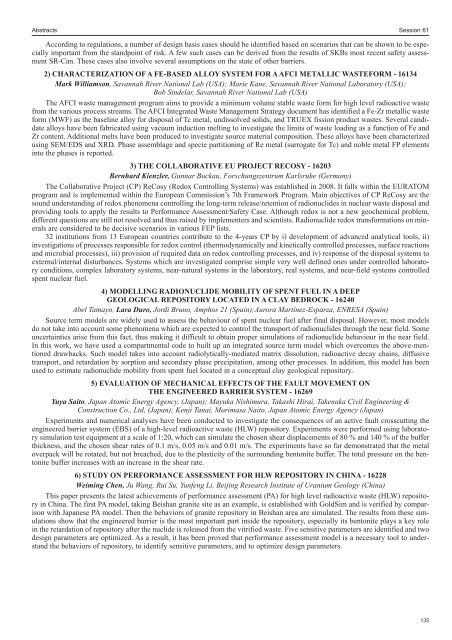The 12th International Conference on Environmental ... - Events
The 12th International Conference on Environmental ... - Events
The 12th International Conference on Environmental ... - Events
Create successful ePaper yourself
Turn your PDF publications into a flip-book with our unique Google optimized e-Paper software.
Abstracts Sessi<strong>on</strong> 61<br />
According to regulati<strong>on</strong>s, a number of design basis cases should be identified based <strong>on</strong> scenarios that can be shown to be especially<br />
important from the standpoint of risk. A few such cases can be derived from the results of SKBs most recent safety assessment<br />
SR-Can. <str<strong>on</strong>g>The</str<strong>on</strong>g>se cases also involve several assumpti<strong>on</strong>s <strong>on</strong> the state of other barriers.<br />
2) CHARACTERIZATION OF A FE-BASED ALLOY SYSTEM FOR A AFCI METALLIC WASTEFORM - 16134<br />
Mark Williams<strong>on</strong>, Savannah River Nati<strong>on</strong>al Lab (USA); Marie Kane, Savannah River Nati<strong>on</strong>al Laboratory (USA);<br />
Bob Sindelar, Savannah River Nati<strong>on</strong>al Lab (USA)<br />
<str<strong>on</strong>g>The</str<strong>on</strong>g> AFCI waste management program aims to provide a minimum volume stable waste form for high level radioactive waste<br />
from the various process streams. <str<strong>on</strong>g>The</str<strong>on</strong>g> AFCI Integrated Waste Management Strategy document has identified a Fe-Zr metallic waste<br />
form (MWF) as the baseline alloy for disposal of Tc metal, undissolved solids, and TRUEX fissi<strong>on</strong> product wastes. Several candidate<br />
alloys have been fabricated using vacuum inducti<strong>on</strong> melting to investigate the limits of waste loading as a functi<strong>on</strong> of Fe and<br />
Zr c<strong>on</strong>tent. Additi<strong>on</strong>al melts have been produced to investigate source material compositi<strong>on</strong>. <str<strong>on</strong>g>The</str<strong>on</strong>g>se alloys have been characterized<br />
using SEM/EDS and XRD. Phase assemblage and specie partiti<strong>on</strong>ing of Re metal (surrogate for Tc) and noble metal FP elements<br />
into the phases is reported.<br />
3) THE COLLABORATIVE EU PROJECT RECOSY - 16203<br />
Bernhard Kienzler, Gunnar Buckau, Forschungszentrum Karlsruhe (Germany)<br />
<str<strong>on</strong>g>The</str<strong>on</strong>g> Collaborative Project (CP) ReCosy (Redox C<strong>on</strong>trolling Systems) was established in 2008. It falls within the EURATOM<br />
program and is implemented within the European Commissi<strong>on</strong>’s 7th Framework Program. Main objectives of CP ReCosy are the<br />
sound understanding of redox phenomena c<strong>on</strong>trolling the l<strong>on</strong>g-term release/retenti<strong>on</strong> of radi<strong>on</strong>uclides in nuclear waste disposal and<br />
providing tools to apply the results to Performance Assessment/Safety Case. Although redox is not a new geochemical problem,<br />
different questi<strong>on</strong>s are still not resolved and thus raised by implementers and scientists. Radi<strong>on</strong>uclide redox transformati<strong>on</strong>s <strong>on</strong> minerals<br />
are c<strong>on</strong>sidered to be decisive scenarios in various FEP lists.<br />
32 instituti<strong>on</strong>s from 13 European countries c<strong>on</strong>tribute to the 4-years CP by i) development of advanced analytical tools, ii)<br />
investigati<strong>on</strong>s of processes resp<strong>on</strong>sible for redox c<strong>on</strong>trol (thermodynamically and kinetically c<strong>on</strong>trolled processes, surface reacti<strong>on</strong>s<br />
and microbial processes), iii) provisi<strong>on</strong> of required data <strong>on</strong> redox c<strong>on</strong>trolling processes, and iv) resp<strong>on</strong>se of the disposal systems to<br />
external/internal disturbances. Systems which are investigated comprise simple very well defined <strong>on</strong>es under c<strong>on</strong>trolled laboratory<br />
c<strong>on</strong>diti<strong>on</strong>s, complex laboratory systems, near-natural systems in the laboratory, real systems, and near-field systems c<strong>on</strong>trolled<br />
spent nuclear fuel.<br />
4) MODELLING RADIONUCLIDE MOBILITY OF SPENT FUEL IN A DEEP<br />
GEOLOGICAL REPOSITORY LOCATED IN A CLAY BEDROCK - 16240<br />
Abel Tamayo, Lara Duro, Jordi Bruno, Amphos 21 (Spain);Aurora Martínez-Esparza, ENRESA (Spain)<br />
Source term models are widely used to assess the behaviour of spent nuclear fuel after final disposal. However, most models<br />
do not take into account some phenomena which are expected to c<strong>on</strong>trol the transport of radi<strong>on</strong>uclides through the near field. Some<br />
uncertainties arise from this fact, thus making it difficult to obtain proper simulati<strong>on</strong>s of radi<strong>on</strong>uclide behaviour in the near field.<br />
In this work, we have used a compartmental code to built up an integrated source term model which overcomes the above-menti<strong>on</strong>ed<br />
drawbacks. Such model takes into account radiolytically-mediated matrix dissoluti<strong>on</strong>, radioactive decay chains, diffusive<br />
transport, and retardati<strong>on</strong> by sorpti<strong>on</strong> and sec<strong>on</strong>dary phase precipitati<strong>on</strong>, am<strong>on</strong>g other processes. In additi<strong>on</strong>, this model has been<br />
used to estimate radi<strong>on</strong>uclide mobility from spent fuel located in a c<strong>on</strong>ceptual clay geological repository.<br />
5) EVALUATION OF MECHANICAL EFFECTS OF THE FAULT MOVEMENT ON<br />
THE ENGINEERED BARRIER SYSTEM - 16269<br />
Yuya Saito, Japan Atomic Energy Agency, (Japan); Mayuka Nishimura, Takashi Hirai, Takenaka Civil Engineering &<br />
C<strong>on</strong>structi<strong>on</strong> Co., Ltd, (Japan); Kenji Tanai, Morimasa Naito, Japan Atomic Energy Agency (Japan)<br />
Experiments and numerical analyses have been c<strong>on</strong>ducted to investigate the c<strong>on</strong>sequences of an active fault crosscutting the<br />
engineered barrier system (EBS) of a high-level radioactive waste (HLW) repository. Experiments were performed using laboratory<br />
simulati<strong>on</strong> test equipment at a scale of 1:20, which can simulate the chosen shear displacements of 80 % and 140 % of the buffer<br />
thickness, and the chosen shear rates of 0.1 m/s, 0.05 m/s and 0.01 m/s. <str<strong>on</strong>g>The</str<strong>on</strong>g> experiments have so far dem<strong>on</strong>strated that the metal<br />
overpack will be rotated, but not breached, due to the plasticity of the surrounding bent<strong>on</strong>ite buffer. <str<strong>on</strong>g>The</str<strong>on</strong>g> total pressure <strong>on</strong> the bent<strong>on</strong>ite<br />
buffer increases with an increase in the shear rate.<br />
6) STUDY ON PERFORMANCE ASSESSMENT FOR HLW REPOSITORY IN CHINA - 16228<br />
Weiming Chen, Ju Wang, Rui Su, Yunfeng Li, Beijing Research Institute of Uranium Geology (China)<br />
This paper presents the latest achievements of performance assessment (PA) for high level radioactive waste (HLW) repository<br />
in China. <str<strong>on</strong>g>The</str<strong>on</strong>g> first PA model, taking Beishan granite site as an example, is established with GoldSim and is verified by comparis<strong>on</strong><br />
with Japanese PA model. <str<strong>on</strong>g>The</str<strong>on</strong>g>n the behaviors of granite repository in Beishan area are simulated. <str<strong>on</strong>g>The</str<strong>on</strong>g> results from these simulati<strong>on</strong>s<br />
show that the engineered barrier is the most important part inside the repository, especially its bent<strong>on</strong>ite plays a key role<br />
in the retardati<strong>on</strong> of repository after the nuclide is released from the vitrified waste. Five sensitive parameters are identified and two<br />
design parameters are optimized. As a result, it has been proved that performance assessment model is a necessary tool to understand<br />
the behaviors of repository, to identify sensitive parameters, and to optimize design parameters.<br />
135
















